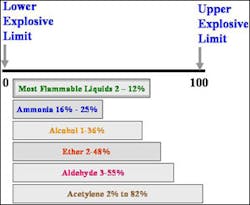The Street Chemist - Part 22
Flammable range is defined as the percent of vapor in air necessary for combustion to occur and is referred to as the explosive limit. It is expressed on a scale from 0 to 100%. Explosive limits consist of an upper explosive limit (UEL) and a lower explosive limit (LEL). Somewhere between the upper and lower explosive limits is a proper mixture of vapor (fuel) and air for combustion to occur. Provided the liquid is above its flash point and the temperature of the ignition source is above the ignition temperature of the liquid. When a liquids vapor is above the upper explosive limit, there is just too much vapor and not enough air for combustion to occur; in other words, the mixture is too rich to burn. Below the lower explosive limit of the liquids vapor, there is enough air but too little vapor for combustion to occur; therefore, the mixture is too lean to burn. Most hydrocarbon flammable liquids have upper and lower explosive limits between 1 and 12%. These limits are considered to be a very narrow flammable range.
So it is not easy to find this small range and have combustion occur. In addition, all of the parameters of combustion conditions must be just right for a fire to occur involving flammable vapors. The liquid must be at its flash point, the air-vapor mixture must be within its flammable range, and the ignition-source temperature must be above the ignition temperature of the liquid. When these conditions do exist, combustion will likely begin.
Other flammable liquids are known to have wide flammable ranges. Wide flammable range materials are very dangerous because they burn very rich with a much more limited amount of air available. It is much easer to find the flammable range of these materials because they are so wide. Alcohols, ethers, and aldehydes are families of flammable liquids that have wide flammable ranges between 0% and 60% in some cases. Wide flammable range materials should be handled with extreme caution. Materials with wide flammable ranges may reach that range inside a container. Fires inside containers can be difficult to extinguish or get to in some cases. Acetylene also has a wide flammable range considered to be between 0% and 80% or above. Firefighters need to be careful when fighting fires involving acetylene tanks. Before any valves are turned off to shut-off the source of acetylene, make sure there is not fire inside the tank or the tank may rupture violently! Other tanks as well should be handled with caution when a suspected wide flammable range material is involved. Wide flammable range liquids are usually polar solvents and require polar solvent or alcohol type foam to extinguish fires. Regular hydrocarbon foam will not be effective.
